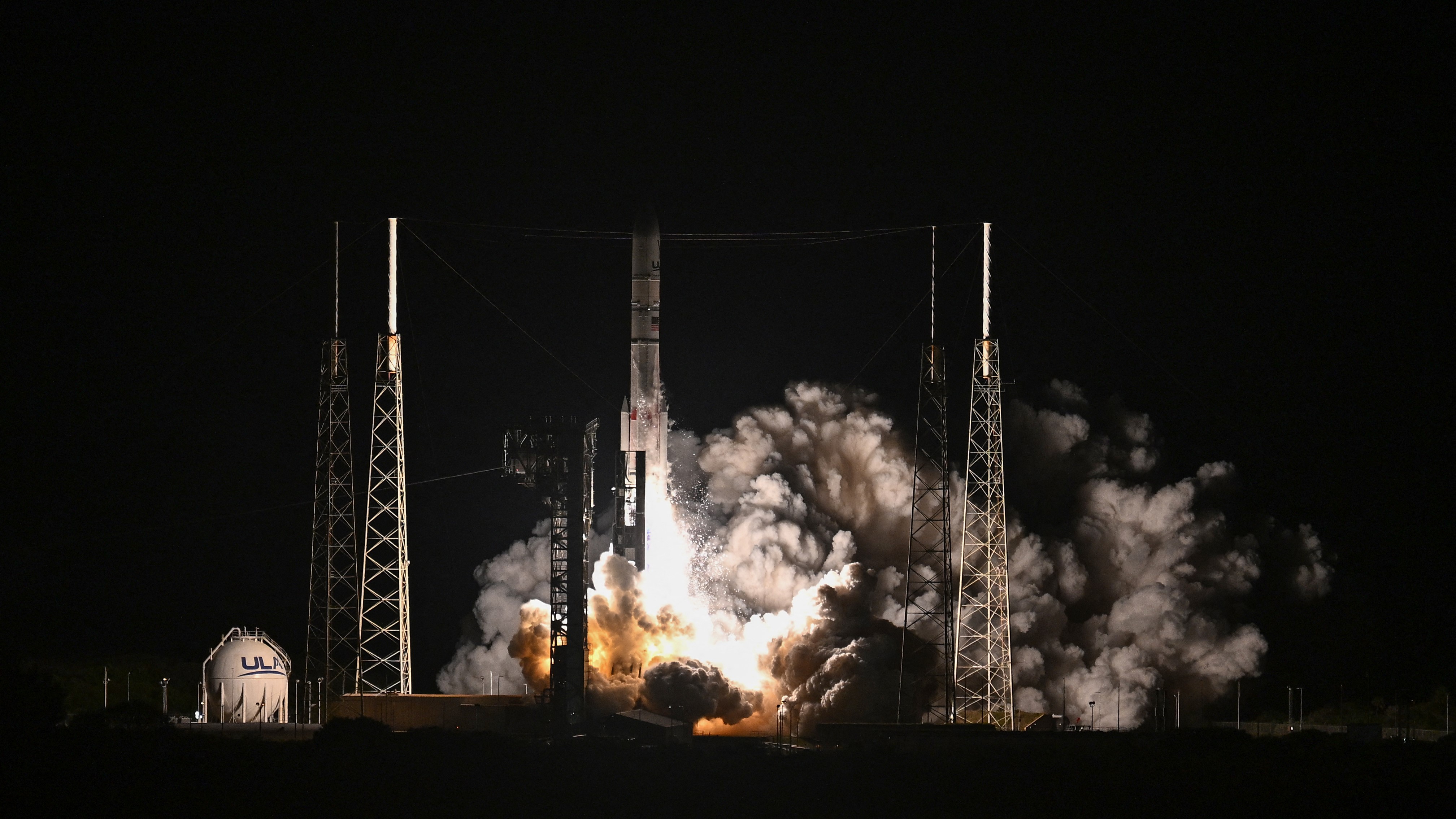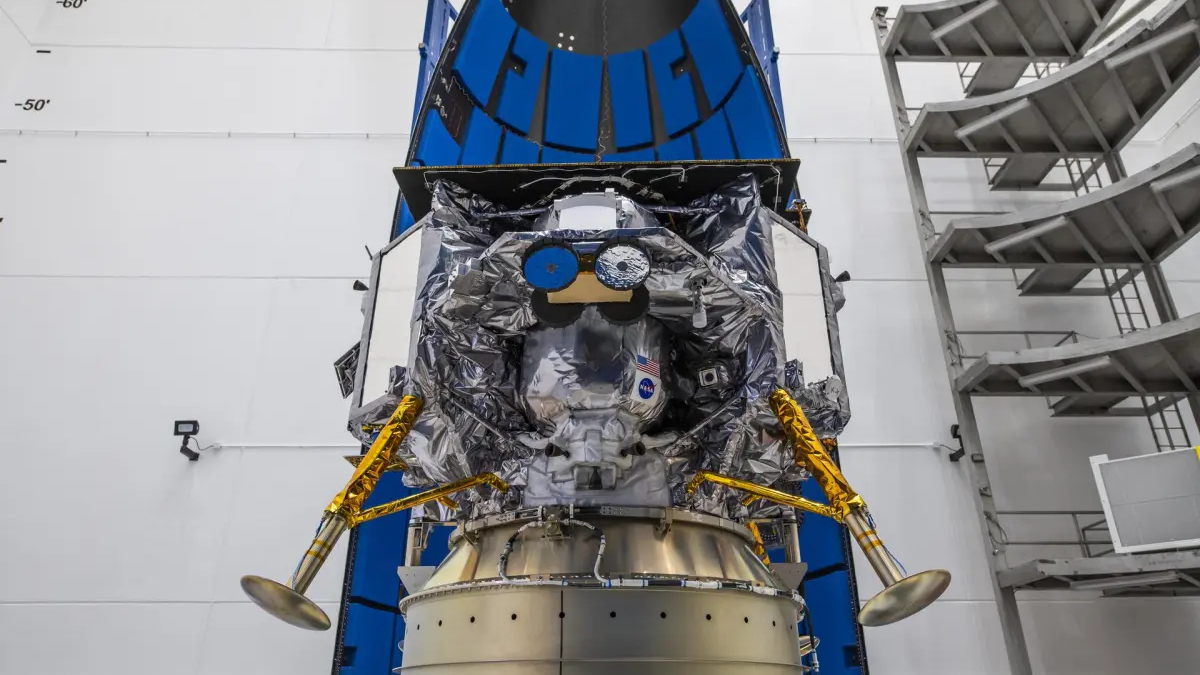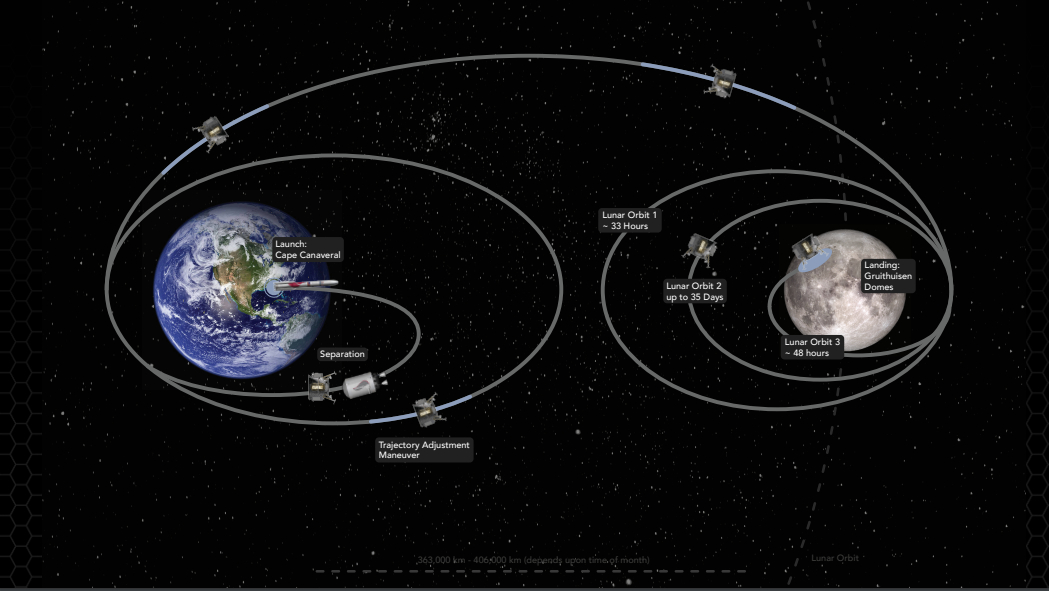
CAPE CANAVERAL, Fla. — A brand-new rocket just got its wings.
United Launch Alliance's (ULA) Vulcan Centaur launched on its first-ever flight, called Cert-1, early this morning (Jan. 8), from Cape Canaveral Space Force Station in Florida.
Vulcan lifted off at 2:18 a.m. EST (0718 GMT), when the rocket's two solid rocket boosters (SRBs) and two Blue Origin-built BE-4 first-stage engines blasted the vehicle skyward with nearly 2 million pounds of thrust. Atop the rocket was Pittsburgh-based company Astrobotic's Peregrine moon lander, which is carrying 20 different customer payloads, including five NASA science instruments.
Related: ULA's 1st Vulcan Centaur rocket launch looks spectacular in these photos and videos

A pillar of exhaust trailed Vulcan as the 202-foot-tall (62 meters) rocket rose above its launch tower and disappeared into the dark Florida sky. About two minutes after liftoff, the SRBs successfully separated from Vulcan's first-stage booster, which continued to climb through Earth's atmosphere.
About five minutes after liftoff, Vulcan's first stage shut its engines down and separated from the Centaur upper stage, which began the first of three burns after a 15-second coast phase. Centaur's first burn lasted about 30 seconds, followed by a longer, four-minute translunar injection burn a half-hour later. About 50.5 minutes after launch, the rocket's primary payload, Peregrine, was released to journey onward toward the moon.
"Yeehaw! I am so thrilled, I can't tell you how much," ULA president and CEO Tory Bruno said just after Peregrine deployed successfully. "So far, this has been an absolutely beautiful mission back to the moon."
Related: Facts about ULA's Vulcan Centaur rocket

If Peregrine lands successfully next month as planned, it will become the first American spacecraft to reach the moon's surface since Apollo 17 in 1972. Peregrine could also be the first private mission ever to touch down on the moon. Astrobotic is locked in a bit of a modern moon race. Another company, Houston-based Intuitive Machines, is also launching a mission to the moon. Intuitive Machines' lander, Nova-C, is launching in a few weeks, but may actually land a day earlier than Peregrine.
However that moon race plays out, Peregrine's mission is significant, especially for NASA, and carries with it a number of firsts. NASA's five scientific payloads aboard the lunar lander are contracted through the space agency's Commercial Lunar Payload Services (CLPS) initiative, with Peregrine providing the program's first service fulfillment.
"It's an exciting time," Joel Kearns, deputy associate administrator for exploration at NASA's Science Mission Directorate, told Space.com in the days leading up to Vulcan's launch.
"It's a totally new way of doing business," Kearns said, "and [the Peregrine mission] is going to be our first data of how it's gonna go."
NASA's CLPS contracts have implications for the agency's Artemis program, which aims to land astronauts on the moon for the first ime in 2025 or 2026 and set up a base on the lunar surface not long afterward. That base will be located in the moon's southern polar region, where water ice appears to be plentiful.
"We have many, many scientific questions about the moon, about all different areas of the moon, but particularly the South Pole," Kearns said. "We'd like to get better prepared to better plan the astronaut visits that will go to the South Pole, and eventually the Artemis base camp will be put there. And we really want to try to generate a lunar ecosystem of companies that are very skilled and successful about turning a service to bring things to the moon."
"We went to each of these companies we've contracted with, and we said, 'We want you to bring our stuff to the moon, operate it and get us our data back.' And it's up to them to design a mission, design a lander, make a lander, buy a launch vehicle, buy all the communications, have a mission control," he added. "They are really a delivery service for us. And that's a really new way of doing things. And we really think there's a lot of benefits to the United States, a lot of advantages of going down that route."
Programs like CLPS are freeing NASA to focus on more cutting-edge research and development, according to Kearns. "We would really like to be in the position that, for things industry could do, we would like to just go to industry and buy that as a service," he said. "And that lets us focus on more state-of-the-art things which are not clear to industry how to do, so that NASA could go pioneer those."
The five NASA science payloads flying to the moon aboard Peregrine will characterize the lunar environment after the lander touches down. The Laser Retroreflector Array (LRA) will use mirrors and lasers to measure very precise distances, and will function as Peregrine's permanent location marker on the lunar surface. The Lunar Energy Transfer Spectrometer (LETS) will measure radiation in the spacecraft's environment, both in lunar orbit and on the moon's surface.
Related: The moon: Everything you need to know about Earth's companion

Three different spectrometers are also part of NASA's Peregrine payloads. They include the Near Infrared Volatile Spectrometers System (NIRVSS), for measuring hydrogen on the moon's surface and subsurface; the Peregrine Ion Trap Mass Spectrometers for Lunar Surface Volatiles (PITMS), which will study the moon's wispy atmosphere; and the Neutron Spectrometer System, which will look for shifts in hydrogen-bearing materials on the surface between the moon's day and night periods.
Astrobotic is carrying a number of non-NASA payloads as well. Indeed, the totality of Peregrine's 20 payloads will enable six nations to send material to the lunar surface for the first time — Mexico, Germany, the United Kingdom, Hungary, the Seychelles and Nepal.
During a press conference on Jan. 5, Astrobotic CEO John Thornton highlighted an especially symbolic payload included on the Peregrine lander. "There's a piece of Everest going back to the moon," he said. "There was actually an astronaut that brought a piece of the moon to the peak of Everest," he explained, referring to a 2010 expedition by NASA astronaut Scott Parazynski, who brought moon rocks collected by the Apollo 11 crew to the top of the world's highest peak. Everest now gets to return the favor, Thornton said.
Another payload aboard Peregrine comes from space memorial company Celestis, which sends customer DNA and cremated remains into space. The company offers a tiered mission structure, which ranges from suborbital flights to missions to Earth orbit, lunar orbit and the lunar surface to a permanent orbit around the sun. Celestis has sent payloads to the lunar surface once before and is doing so again on Peregrine, with a mission the company calls Luna Tranquility.
Tranquility includes the DNA of 66 mission "participants," whose remains will be permanently situated on the moon's surface following Peregrine's landing. Though the plans and payloads for Celestis' Tranquility flight were publicly announced years before the mission finally made it to the launch pad, objections about depositing human remains on the moon surfaced less than a month ago.
In a Dec. 21 letter to NASA and the U.S. Department of Transportation (USDOT), President of the Navajo Nation Buu Nygren requested that the memorial launch be postponed, saying that "the act of depositing human remains and other materials, which could be perceived as discards in any other location, on the moon is tantamount to desecration of this sacred space."
In prelaunch briefings and interviews leading up to the Cert-1 launch, NASA officials stressed the nature of commercial contracts, and the agency's inability to assert that type of authority over a private company's actions. "This isn't NASA's mission," Kearns told Space.com.
Kearns also pointed out that NASA makes the effort to consider a wide variety of implications when planning its missions, citing as an example a conference in the spring of 2023.
"In April this past year, we hosted at NASA Headquarters a workshop to get input from a variety of people on what we ended up calling, in shorthand, 'ethics of Artemis,'" he said. "And it was the idea to get non-traditional groups that probably don't deal with the scientific or engineering aspects of our future projected work on the moon and Mars to give us their inputs on things that they think that we or the U.S. government-wide should consider in the future."
Celestis CEO Charles Chafer said he wishes the concerns had been raised well before the rocket and payload had reached a logistical point of no return. "We also strongly disagree with the characterization of our reverent, carefully prepared by aerospace and funeral service professionals, flight capsules that are permanently encased in the lunar lander and not released onto the lunar surface as desecration," Chafer said in a statement. "Our clients consider our service an appropriate celebration — the polar opposite of desecration."
Tranquility isn't the only Celestis mission flying on the Cert-1 launch. The company also put a payload called Enterprise on the rocket's Centaur upper stage. That mission, aptly named, has been decades in the making. It includes DNA from "Star Trek" creator Gene Roddenberry and his wife, Majel Barrett-Roddenberry, as well as the remains from several actors from the original TV series, including Nichelle Nichols, James Doohan and DeForest Kelley, who played Lieutenant Uhura, Chief Engineer "Scotty" and CMO Leonard "Bones" McCoy, respectively.
The DNA from some of these folks' living relatives is also flying on Celestis' Enterprise flight, including Rod Roddenberry, the son of Gene and Majel, and Wende Doohan, the widow of James.
"I feel like this is our last adventure together," Wende Doohan told Space.com during a Celestis event honoring the mission participants. James Doohan died in 2005, and Wende thinks he would love this tribute. "If he had had a chance to fly while he was still alive, he would have adored it. It was the best thing that he could think of to do," Doohan said. "Had he been alive when Bill went up into space, he would have fought him for the seat, I'll tell you."
"Bill" is William Shatner, who played Capt. Kirk on "Star Trek." Shatner launched on a suborbital flight aboard Blue Origin's New Shepard rocket in October 2021.
"I truthfully see all this as an incredibly beautiful, symbolic kind of thing," Rod Roddenberry told Space.com. This isn't the first Celestis flight to include the "Star Trek" creator's ashes, but it is the first with Gene and Majel together.
"My mother made [Charles Chafer] promise that when she passed away, that he would take her ashes and my father's ashes, and not just send them up into orbit, but launch them out into space," Rod said. "We are at the event that is celebrating not just my mother and father, but many other notables in 'Star Trek,' as well as many other people who have signed up for this and shared their families remains, as well as their DNA to be launched into space. Everyone is going where no one has gone before."
The "Star Trek" notables aren't the only ones aboard the Enterprise flight, which is headed to an orbit around the sun aboard Centaur. The mission includes material from 270 participants, including DNA from former U.S. presidents George Washington, Dwight D. Eisenhower and John F. Kennedy.

As its mission name suggests, this is Vulcan's first certification flight. The rocket will need to launch a second time in order to obtain the clearances the rocket needs.
"We've been working with the U.S. Space Force for multiple years on the certification of Vulcan, and it goes really much further beyond just the two certification flights," Mark Peller, vice president of major development at ULA, said during a pre-launch press briefing. "Obviously, these are very significant, but the U.S. Space Force has partnered with us throughout development and has full insight into design and development."
The development of Vulcan was a lengthy process, lasting about a decade. Its debut was originally targeted for 2019, but issues with the launch vehicle and its BE-4 engines delayed the launch multiple times. Despite these problems, ULA representatives voiced confidence in the rocket in the days leading up to liftoff.
"We're building on more than 120 years of combined Atlas and Delta experience," Gary Wentz, ULA's vice president of government and commercial programs, said during the Jan. 5 teleconference, referring to the company's venerable Atlas V and Delta rockets.
"As we brought Vulcan onboard and designed the systems, we leveraged the existing systems as much as possible from Atlas and Delta," Wentz added. "When you look, the only hardware that hasn't flown prior to this flight is the BE-4 engines; all the others, or variants thereto, have flown on either Atlas or Delta flights on missions for other customers."
Astrobotic CEO Thornton said he trusted Peregrine to fly on a brand-new rocket. "The reason we went with United Launch Alliance — first, we have the same belief in them as a company and they have a story and track record like no other on Earth, with decades of success under their belt. Vulcan has a new name, but it really is an upgraded Atlas V, so that gives us great comfort in that as well," Thornton said on Jan. 5.
Now, Peregrine is on its own, headed toward the moon to attempt what few have accomplished — a fact not lost on Thornton. "Flying to the surface of the moon and operating lunar missions is a very, very challenging business to go about," he said. "If you look back in the course of history, only about half of those missions have been successful. And most of those have been funded by superpowers, with vastly larger budgets than this mission has been granted," Thornton said.
Indeed, landing on the moon is a feat accomplished so far by just four nations — the Soviet Union, the United States, China and India — and no private companies. Sharad Bhaskaran, Peregrine mission director at Astrobotic, explained to Space.com how the company tried to design its lunar lander to ensure success.
"The main thing we tried to do is simplify it," Bhaskaran said in a Jan. 5 interview. "We don't articulate our solar panel when we are in orbit. It's fixed on the top of the spacecraft, so we have a sun-pointing orientation to maintain power margins. The only thing that articulates is, after we land, we have a medium-gain antenna that deploys to give us a high-bandwidth transmission of science data. But we did that intentionally, because the more things you have deployed and articulate, the more potential risks there are, single-point failures on mission critical-features on the spacecraft."
After its separation from Centaur, Peregrine's first step was to establish communications and orient itself toward the sun. Ahead in its journey to the moon, Peregrine will fly a phasing loop around Earth and perform necessary course corrections to adjust the spacecraft's approach to the moon.
Related: Missions to the moon: Past, present and future
Peregrine is scheduled to enter a high, elliptical orbit around the moon, and gradually lower and circularize its altitude to about 62 miles (100 kilometers) before beginning its landing descent. This won't happen until Peregrine's landing site is on the lunar day-side. Currently, the spacecraft is scheduled to land in the moon's south polar region on Feb. 23.
"Once we begin descent, it's about one hour down to the surface," Thornton explained, saying the landing "will be exciting, nail-biting, terrifying all at once, and a whole range of emotions."
With this first Vulcan launch complete, ULA has an ambitious timeline for the new rocket in 2024. In contrast to 2023, which saw just three ULA launches, the company is planning for double that in Vulcan missions alone.
"We have six Vulcans on the manifest this year," Wentz said on the Jan. 5 call, "and just like with Atlas and Delta, it's dependent upon the contracts, and whether or not the spacecraft are ready to support those launches. So we anticipate some movements in the manifest, but right now, as a baseline, there's six Vulcan contractually on the manifest."
According to Wentz, if data from Vulcan's first launch comes back nominal, "we would be prepped and ready to proceed right now." He said April is the earliest likely opportunity for Vulcan to fly Cert-2, which will launch the first mission of Sierra Space's Dream Chaser cargo space plane to the International Space Station. That schedule, Wentz added, "would be worked in concert with the NASA team and space station availability."







